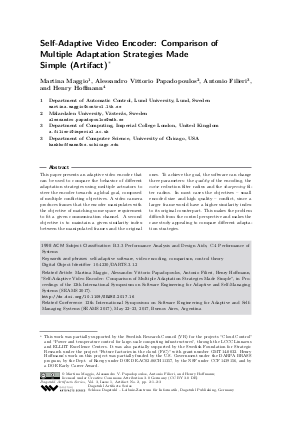Self-Adaptive Video Encoder: Comparison of Multiple Adaptation Strategies Made Simple (Artifact)
Authors Martina Maggio, Alessandro Vittorio Papadopoulos, Antonio Filieri, Henry Hoffmann
-
Part of:
Issue:
Special Issue of the 12th International Symposium on Software Engineering for Adaptive and Self-Managing Systems (SEAMS 2017)
Part of: Volume: DARTS, Volume 3 (ECOOP 2017)
Part of: Journal: Dagstuhl Artifacts Series (DARTS) - License:
 Creative Commons Attribution 3.0 Germany license
Creative Commons Attribution 3.0 Germany license
- Publication Date: 2017-05-16
Artifact Description

PDF
DARTS.3.1.2.pdf
- Filesize: 419 kB
- 3 pages
Document Identifiers
Subject Classification
Keywords
- self-adaptive software
- video encoding
- comparison
- control theory
Metrics
- Access Statistics
-
Total Accesses (updated on a weekly basis)
0PDF Downloads0Metadata Views
Artifact
DARTS-3-1-2-artifact-db50a41ad64af79ed5cf7f181864e7c0.tgz
(Filesize: 23.87 MB)
MD5 Sum:
db50a41ad64af79ed5cf7f181864e7c0
(Get MD5 Sum)
Abstract
This paper presents an adaptive video encoder that can be used to compare the behavior of different adaptation strategies using multiple actuators to steer the encoder towards a global goal, composed of multiple conflicting objectives. A video camera produces frames that the encoder manipulates with the objective of matching some space requirement to fit a given communication channel. A second objective is to maintain a given similarity index between the manipulated frames and the original ones. To achieve the goal, the software can change three parameters: the quality of the encoding, the noise reduction filter radius and the sharpening filter radius. In most cases the objectives - small encoded size and high quality - conflict, since a larger frame would have a higher similarity index to its original counterpart. This makes the problem difficult from the control perspective and makes the case study appealing to compare different adaptation strategies.
Cite As Get BibTex
Martina Maggio, Alessandro Vittorio Papadopoulos, Antonio Filieri, and Henry Hoffmann. Self-Adaptive Video Encoder: Comparison of Multiple Adaptation Strategies Made Simple (Artifact). In Special Issue of the 12th International Symposium on Software Engineering for Adaptive and Self-Managing Systems (SEAMS 2017). Dagstuhl Artifacts Series (DARTS), Volume 3, Issue 1, pp. 2:1-2:3, Schloss Dagstuhl – Leibniz-Zentrum für Informatik (2017)
https://doi.org/10.4230/DARTS.3.1.2
BibTex
@Article{maggio_et_al:DARTS.3.1.2,
author = {Maggio, Martina and Papadopoulos, Alessandro Vittorio and Filieri, Antonio and Hoffmann, Henry},
title = {{Self-Adaptive Video Encoder: Comparison of Multiple Adaptation Strategies Made Simple (Artifact)}},
pages = {2:1--2:3},
journal = {Dagstuhl Artifacts Series},
ISSN = {2509-8195},
year = {2017},
volume = {3},
number = {1},
editor = {Maggio, Martina and Papadopoulos, Alessandro Vittorio and Filieri, Antonio and Hoffmann, Henry},
publisher = {Schloss Dagstuhl -- Leibniz-Zentrum f{\"u}r Informatik},
address = {Dagstuhl, Germany},
URL = {https://drops.dagstuhl.de/entities/document/10.4230/DARTS.3.1.2},
URN = {urn:nbn:de:0030-drops-71408},
doi = {10.4230/DARTS.3.1.2},
annote = {Keywords: self-adaptive software, video encoding, comparison, control theory}
}
Author Details
Supplementary Materials
References
- Antonio Filieri, Henry Hoffmann, and Martina Maggio. Automated design of self-adaptive software with control-theoretical formal guarantees. In Proceedings of the 36th International Conference on Software Engineering, ICSE, pages 299-310, New York, NY, USA, 2014. ACM. URL: http://doi.acm.org/10.1145/2568225.2568272, URL: http://dx.doi.org/10.1145/2568225.2568272.
-
Zhou Wang, A.C. Bovik, H.R. Sheikh, and E.P. Simoncelli. Image quality assessment: from error visibility to structural similarity. IEEE Transactions on Image Processing, 13(4):600-612, 2004.

